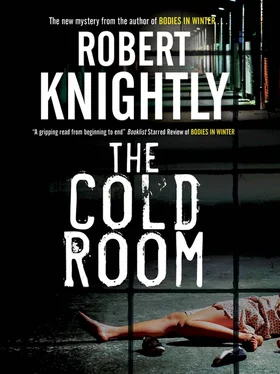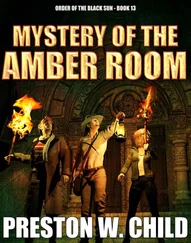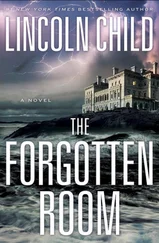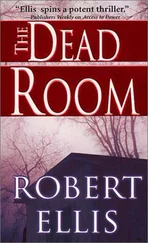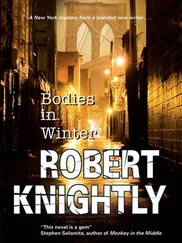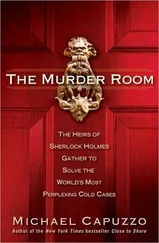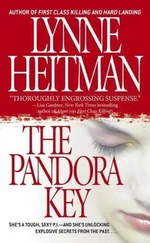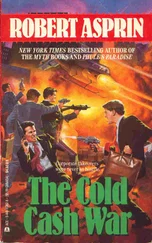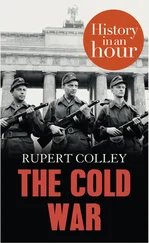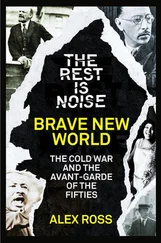Robert Knightly - The cold room
Здесь есть возможность читать онлайн «Robert Knightly - The cold room» весь текст электронной книги совершенно бесплатно (целиком полную версию без сокращений). В некоторых случаях можно слушать аудио, скачать через торрент в формате fb2 и присутствует краткое содержание. Жанр: Полицейский детектив, на английском языке. Описание произведения, (предисловие) а так же отзывы посетителей доступны на портале библиотеки ЛибКат.
- Название:The cold room
- Автор:
- Жанр:
- Год:неизвестен
- ISBN:нет данных
- Рейтинг книги:3 / 5. Голосов: 1
-
Избранное:Добавить в избранное
- Отзывы:
-
Ваша оценка:
- 60
- 1
- 2
- 3
- 4
- 5
The cold room: краткое содержание, описание и аннотация
Предлагаем к чтению аннотацию, описание, краткое содержание или предисловие (зависит от того, что написал сам автор книги «The cold room»). Если вы не нашли необходимую информацию о книге — напишите в комментариях, мы постараемся отыскать её.
The cold room — читать онлайн бесплатно полную книгу (весь текст) целиком
Ниже представлен текст книги, разбитый по страницам. Система сохранения места последней прочитанной страницы, позволяет с удобством читать онлайн бесплатно книгу «The cold room», без необходимости каждый раз заново искать на чём Вы остановились. Поставьте закладку, и сможете в любой момент перейти на страницу, на которой закончили чтение.
Интервал:
Закладка:
Robert Knightly
The cold room
ONE
I was alone, except for the body, and for a white-hot July sun directly overhead. The sky was milky to the horizon, the atmosphere so charged with ozone, it seemed as if the merest spark would set off an explosion. Before me, strips of yellow tape closed the mouth of a short street paved with cobblestones. The cobblestones ended at the foot of an oblong dirt mound overgrown with dried weeds and yellowing grass. According to Officer Manny Bloom, the body of a deceased white female was positioned between the dirt and a head-high fence that prevented access to the East River.
I stood where I was for a long moment, watching the lights of Officer Bloom’s cruiser retreat to the mouth of the Williamsburg Bridge five blocks to the west. The reason for my isolation was up on the Bridge; a derailed, Manhattan-bound J Train that had initially re-kindled the fears unleashed by the attack on the World Trade Center. As all New Yorkers know, these fears do not go away. They hibernate, instead, like frogs in the bed of a dry pond, prepared to regenerate at the first drop of rain.
When the truth finally emerged later in the day, the facts, though bizarre, were far less threatening. A transit cop working in plain clothes had encountered a psycho threatening his fellow passengers with a long-bladed kitchen knife. The officer’s adrenals had instantly jumped into high gear, causing him to skip the part in the Patrol Guide about identifying himself as a police officer before taking action. He’d simply drawn his weapon from its holster at the small of his back, then shouted: ‘Drop the fuckin’ knife, shitface!’ But that’s the problem with EDPs, the PD’s politically correct term for psychos, they just can’t take a hint, not even when it’s reinforced by a 9mm Browning. The EDP had lunged at the officer and the officer had fired three times, instantly terminating the EDP’s life.
The shooting was justified and the undercover would have been hailed as a hero if the incident had concluded at that point. As it was, a panicked rider at the far end of the car yanked the emergency brake, causing three cars to jump the tracks and slam into the side of a Brooklyn-bound train.
By the time I arrived, at noon, everybody was up on the bridge: bosses by the dozen, every CSU and Emergency Service team in the city, the Fire Department, the Mayor and six administrative aides, the Metropolitan Transportation Authority, every morgue wagon, the FBI, the Department of Homeland Security and the Secret Service.
That left my home base, the 92nd Precinct in the Brooklyn neighborhood of Williamsburg, virtually without a police presence, the shortage of personnel so acute that I’d been called out of bed to cover this inconvenient murder. But I didn’t mind. This was the first homicide I’d worked in the last nine months and my senses were on full alert.
No more than fifty yards long, the short block was an extension of South Fifth Street running between Kent Avenue and the East River. It was enclosed on either side by the walls of two long buildings, both shut down on a Sunday morning. The building to the south, occupied by Yang Electrical Contractors, was three stories high and almost directly beneath the Williamsburg Bridge, already a hundred feet above the ground at that point. The building to the north, home of Gambrelli amp; Sons Italian Furniture, was four stories high and constructed of brick. Like its neighbor, all of its lower windows were protected by steel grates.
Behind me, South Fifth Street was solidly industrial, as was Kent Avenue for several blocks in both directions. The only retail business visible from where I stood, a bar on the other side of Kent Avenue, was closed. Williamsburg is a mixed residential and industrial community, with low-rise warehouses and small apartment buildings commonly jumbled together on the same block. That was not the case here. Even Kent Avenue, heavy with commercial traffic during the week, was totally deserted. It was the perfect spot to dump a body on a Sunday morning in July.
I began to walk down the center of the cobblestoned street toward the mound. Twenty yards in, and slightly to the left, I found a pothole created when a number of cobblestones had been removed. I dropped to my knees, then wiped the sweat from my eyes before taking a closer look. At the bottom of the pothole, enough dirt had accumulated to record the impression of a passing tire. I could see the ridges left by the tire clearly enough. Though very faint, they seemed intact.
I rose and walked back to my car, stripping off my jacket and tie along the way. I tossed both onto the back seat, then started the engine, enduring a blast of hot air from the vents in the dashboard. The Crown Vic’s air conditioning had long ago ceased to function unless the car was in motion, but the radio worked well enough. I had Central patch me through to the desk officer at the Nine-Two, Sergeant Bill Sabado.
‘It’s Harry Corbin, sarge,’ I said.
‘Yeah?’
Sabado’s tone was cold, but I was used to that. A year before, I’d exposed a den of vipers nestled in the bosom of the NYPD. I had yet to be forgiven.
‘Any chance,’ I asked, ‘that CSU is gonna be able to respond?’ Ordinarily, the Crime Scene Unit processes murder scenes, bringing their equipment and considerable expertise with them. ‘I’m working with some very faint-’
‘Negative, detective. CSU has no available units.’
And that was that. I shut down the engine, then retreated to the trunk where I removed a cardboard box. The box contained a Polaroid camera, a twenty-five foot tape measure, a few evidence bags, and several pairs of latex gloves. I carried the box to the pothole, set it on the cobblestones, and finally tore off a strip of cardboard. By folding the edge of the cardboard to create a little platform, I was able to stand it upright beside the pothole. Later, when I photographed the scene from Kent Avenue, the strip of cardboard would serve as an evidence marker.
As I straightened up, I felt as if I was pushing against active resistance. There was the sun, a presence I felt in every pore, and the humidity, of course, and a multi-layered wall of noise that hammered me from above. Sirens first, wailing and honking as they rolled up to the wreck, and then the scream of a saw blade cutting into metal. Finally, a steady pounding from the rotors of the news, police and military helicopters stationed above the bridge.
I looked up at that point, my eye drawn to the flashing lights of a hundred vehicles ricocheting across the steel girders of the bridge’s massive towers. Red, white, yellow and blue, the lights seemed almost festive.
After a moment, I continued along the middle of the street until I came within a few yards of the mound. Four feet high, the mound was composed of mixed dirt and rubble, most likely deposited when an enterprising truck driver took a short-cut to the dump. But that had been a long time ago, long enough for the city’s hardiest weeds and grasses to root. Against the wall of Yang Contractors, slender as a whip, an alianthus sapling rose to the height of my head.
It wasn’t my intention to examine the body on my first approach, but my eyes were inevitably drawn to a path, about three feet wide, where the weeds and grass had been flattened. Most of the grass had sprung back up, but the weeds were having a tougher time of it. Their heads faced away from me, toward the river, the stalks broken, and it was obvious that something heavy had been dragged over them. I stepped forward to examine the swath more closely. My reward was a persistent hum that nicely complemented the steady chop of the rotor blades overhead. I recognized the source of that hum, flies drawn to a generous feed and a spot to lay their eggs. If I moved any closer, they would rise in a black cloud, their hum transformed into an outraged buzzing as they circled my head.
Читать дальшеИнтервал:
Закладка:
Похожие книги на «The cold room»
Представляем Вашему вниманию похожие книги на «The cold room» списком для выбора. Мы отобрали схожую по названию и смыслу литературу в надежде предоставить читателям больше вариантов отыскать новые, интересные, ещё непрочитанные произведения.
Обсуждение, отзывы о книге «The cold room» и просто собственные мнения читателей. Оставьте ваши комментарии, напишите, что Вы думаете о произведении, его смысле или главных героях. Укажите что конкретно понравилось, а что нет, и почему Вы так считаете.
